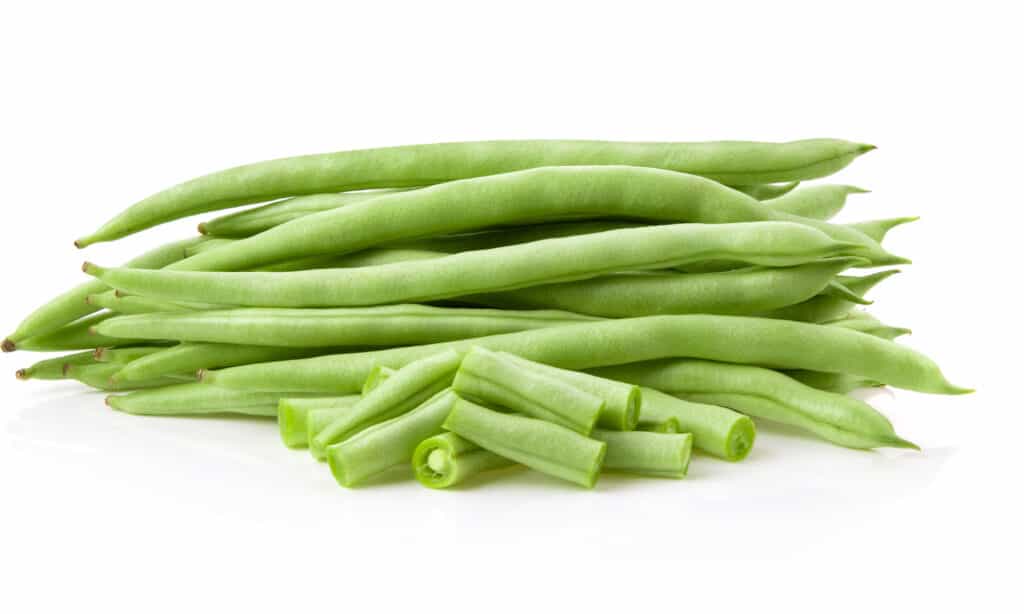String beans are a familiar veggie in the kitchen popping up in casseroles, curries, stir fries, bacon dishes, and salads. They’re eaten around the world and they are really good for our health, so you may have wondered at some point can dogs eat string beans too? The good news is yes, string beans are a healthy snack for dogs so long as you’re careful and mitigate the small risks.
Let’s find out how to give dogs string beans safely, and why it’s a good idea they eat some!
Are String Beans Good for Dogs?

String beans contain many vitamins, minerals, and fiber, and are a healthy treat for dogs when fed in moderation.
©leonori/Shutterstock.com
Yes, both raw and cooked string beans are good for dogs so long as they are served up plain and total no more than 10% of their daily food allowance. The ASPCA recommends 10% or less of a dog’s daily food allowance is given as treat food and the rest should be complete dog food.
String beans contain lots of vitamins, minerals, fiber, and antioxidants so your dog can really benefit from them.
Wait, Aren’t Dogs Meat Eaters?

Dogs certainly love meat, but they enjoy vegetables, too.
©iStock.com/vasiliybudarin
Some people are surprised by the fact that beans are good for dogs because they thought dogs were meat-eating carnivores. Well, domestic dogs have a common ancestor in the wild wolf, and wolves are carnivores, but domestic dogs have lived alongside humans for at least 11,000 years and they’ve evolved to eat some of the food we’ve traditionally eaten including fruits, veggies, berries, and starches. This makes them omnivores like us.
Just for interest, domestic cats are obligate carnivores. They haven’t evolved in the same way, because as we know, cats do as they please!
What Are String Beans?

String beans have many names, the most common of which being green beans. The name string bean refers to the string that runs alongside the pod when they grow. Most store-bought varieties of green beans have had this string removed.
©pukao/Shutterstock.com
String beans are a bean of many names. Their scientific name is Phaseolus vulgaris, but they’re also called French beans, snap beans, haricot vert, and green beans. The beans are immature bean pods that are eaten whole before the seeds have time to get any bigger than a few millimeters in size.
The “string” part of its name refers to the fibrous string that runs alongside the pod. Most modern cultivars don’t have the string any more, because it had to be removed before cooking and consumers preferred the stringless versions that started appearing in 1894. So string beans are usually stringless beans despite their name.
The plant originates from central and south America and archaeological evidence indicates they’ve been cultivated for thousands of years. The humble string bean has sustained humans for millennia and continues to do so even today. 32 million tonnes were produced worldwide in 2020!
Health Benefits of String Beans for Dogs

String beans are a good treat for dogs, with nutrients that can help keep them healthy and happy.
©Blanscape/Shutterstock.com
String beans are packed with nutrients and they punch well above their weight in terms of vitamins and minerals. Here are just a few of the nutrients your dog can gain from eating string beans.
- Vitamin C – Important for a healthy immune system.
- Vitamin K – Supports blood clotting and fast-healing wounds.
- B vitamins – Converts food into energy for bouncy enthusiasm.
- Manganese – Forms connective tissue, blood, bones and sex hormones.
- Protein – Builds strong, healthy muscles.
- Iron – Helps form red blood cells.
- Calcium – Forms strong bones, teeth, and nails.
- Fiber – Full of fiber for healthy bowels and regular stools.
Low Calorie
String beans are also low in calories, in fact, they are 90% water! Overweight dogs are common in the US. The Association for Pet Obesity Prevention says 56% of pet dogs are overweight or obese. Excess weight really reduces a dog’s quality of life and makes mobility problems, diabetes, cancer and other life-limiting diseases more likely.
The good news is string beans are really low fat, so they can form part of a healthy diet or help overweight dogs slim down without feeling hungry.
Low Fat
String beans have barely any fat in them, which is excellent news for dog owners dealing with pancreatitis. Pancreatitis in dogs is provoked by high-fat oily foods and it’s a really painful condition for them, not to mention expensive for the owner who will need to provide pain relief, anti-nausea medication, and even antibiotics to control the flare-up each time it occurs.
String beans won’t trigger pancreatitis unless they’re cooked in oil. More on that next!
String Bean Risks for Dogs

There aren’t many risk factors with giving your dog string beans, but a few are worthy of note.
©Konstantin Zaykov/Shutterstock.com
Here are the risks string beans may pose for your pooch. There aren’t many, but they are worth being aware of.
Cooking With Other Ingredients
Oil and Butter
Plain string beans are great for dogs, but when they’re prepared with other ingredients they can turn into a problem. For example, frying string beans is a common preparation method, but the butter and oil used to cook them up can cause pancreatitis and unnecessary weight gain.
Salt
Too much salt causes hypertension (high blood pressure) and because dogs are smaller than us, they need much less salt to get ill. Hypertension can cause detached retinas, blindness, heart conditions, and even be fatal. Don’t add salt to your dog’s string bean meal.
Spices
Cooking string beans with onion and garlic smells divine and your dog will show a lot of interest, but garlic and onions are toxic. Dogs can’t digest the compounds and they lead to anemia.
Choking Hazard
Feeding large raw string beans to a dog may inadvertently choke them. String beans are long and thin, so they can get lodged in the throat or esophagus and get stuck. This risk increases if the bean has an actual string because the string is tough and difficult to chew or swallow. Most modern store-bought string beans don’t have the string now, so it’s usually not a problem, but if you’re growing heirloom varieties for the table it’s worth thinking about.
Chop up string beans to decrease any choking hazards, especially for puppies, older dogs, or dogs that snatch and swallow.
Upset Stomachs
String beans are fiber-packed, and this is usually a good thing, but too much fiber can lead to diarrhea and other gastric upsets like excessive flatulence and vomiting.
If this happens, cut down string bean consumption and give your dog small plain meals of turkey or chicken with rice until their stools return to normal. If the upset lasts more than a few days it’s best to consult with your vet.
Can String Beans Help Dogs Lose Weight?
String beans can help dogs lose weight if they’re fed as part of a healthy diet and your dog is getting plenty of exercise to burn off the excess fat.
Substituting string beans for treats like dog biscuits or human food from the table will cut down their calorie intake and contribute to weight loss, but it’ll work faster when coupled with size and breed-appropriate exercise.
How To Cook String Beans for Dogs

While dogs can eat raw string beans, they can also eat the beans cooked in plain water or by steam.
©Thomas Holt/Shutterstock.com
Dogs can eat raw string beans and they adore the “cronch” but it’s possible to cook them up as well.
The best way to cook string beans for a dog is by simmering them in water, steaming or boiling them. Avoid cooking green beans in oil to avoid weight gain or pancreatitis flare-ups.
You can use fresh, canned, or frozen string beans, but be sure to rinse tinned beans in water to remove any preservatives first.
Offer them raw or cooked as a treat, a training aid, in a puzzle ball, or added to their main meal for variety.
What Food Is Poisonous for Dogs?
Whilst string beans are great for dogs, there are toxic food and drinks they should never consume. These include alcohol, chocolate, the artificial sweetener xylitol, macadamia nuts, nutmeg, grapes, raisins, stone fruit pits, avocado, onions, and garlic.
All of these foods are toxic and capable of causing dog fatalities.
Are String Beans Dangerous for Dogs?
String beans are good for dogs because they offer lots of nutrients and contain very little fat.
So long as they are plain and chopped up, string beans are a healthy snack for dogs to enjoy. Other healthy fruit and veggie snacks include strawberries, blueberries, bell peppers, sliced carrots, sliced apples, and edamame beans. Just offer small amounts to give your pooch an interesting and healthy diet without upsetting their stomach.
Up Next…
Ready to discover the top 10 cutest dog breeds in the entire world?
How about the fastest dogs, the largest dogs and those that are -- quite frankly -- just the kindest dogs on the planet? Each day, AZ Animals sends out lists just like this to our thousands of email subscribers. And the best part? It's FREE. Join today by entering your email below.
Thank you for reading! Have some feedback for us? Contact the AZ Animals editorial team.








